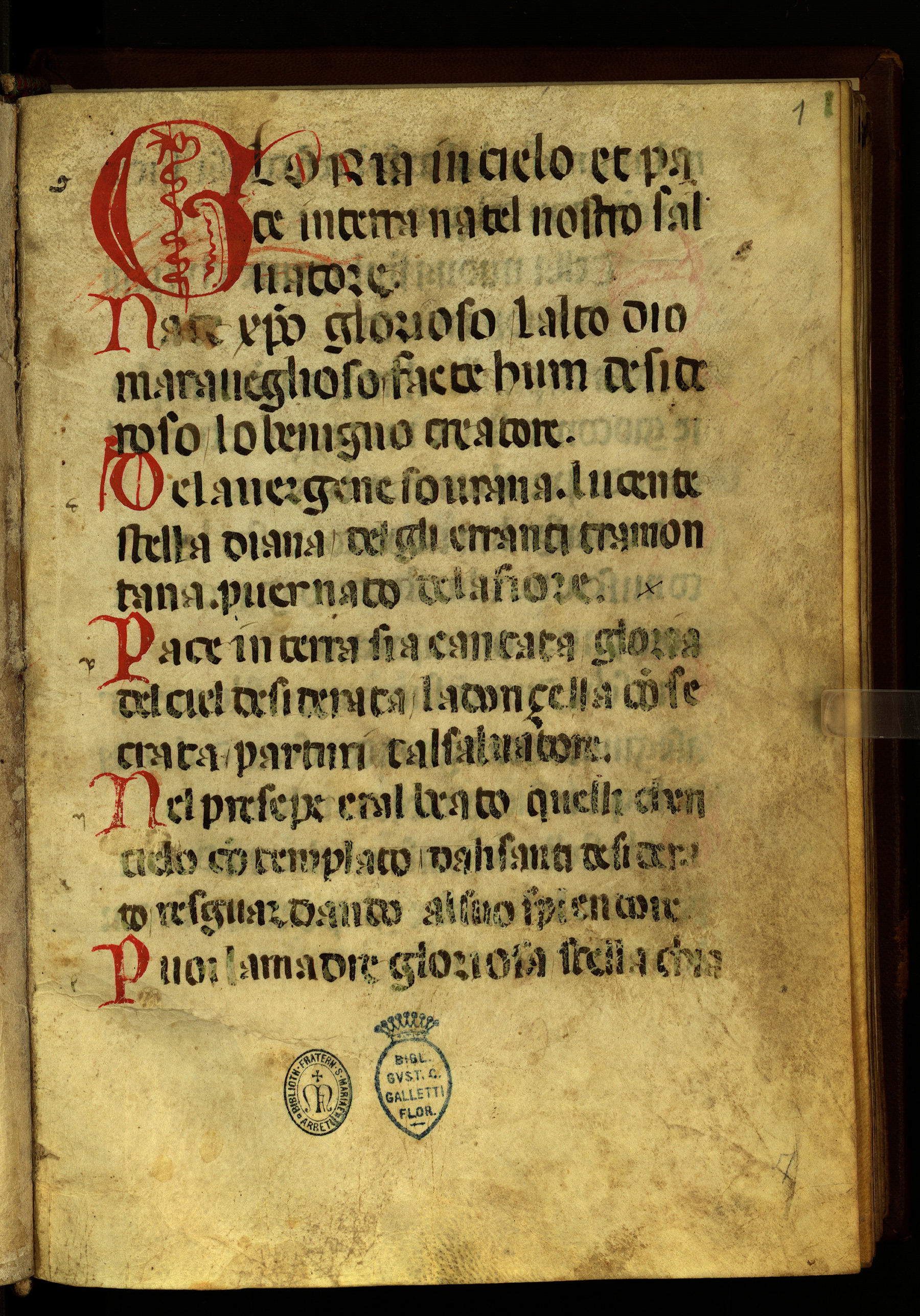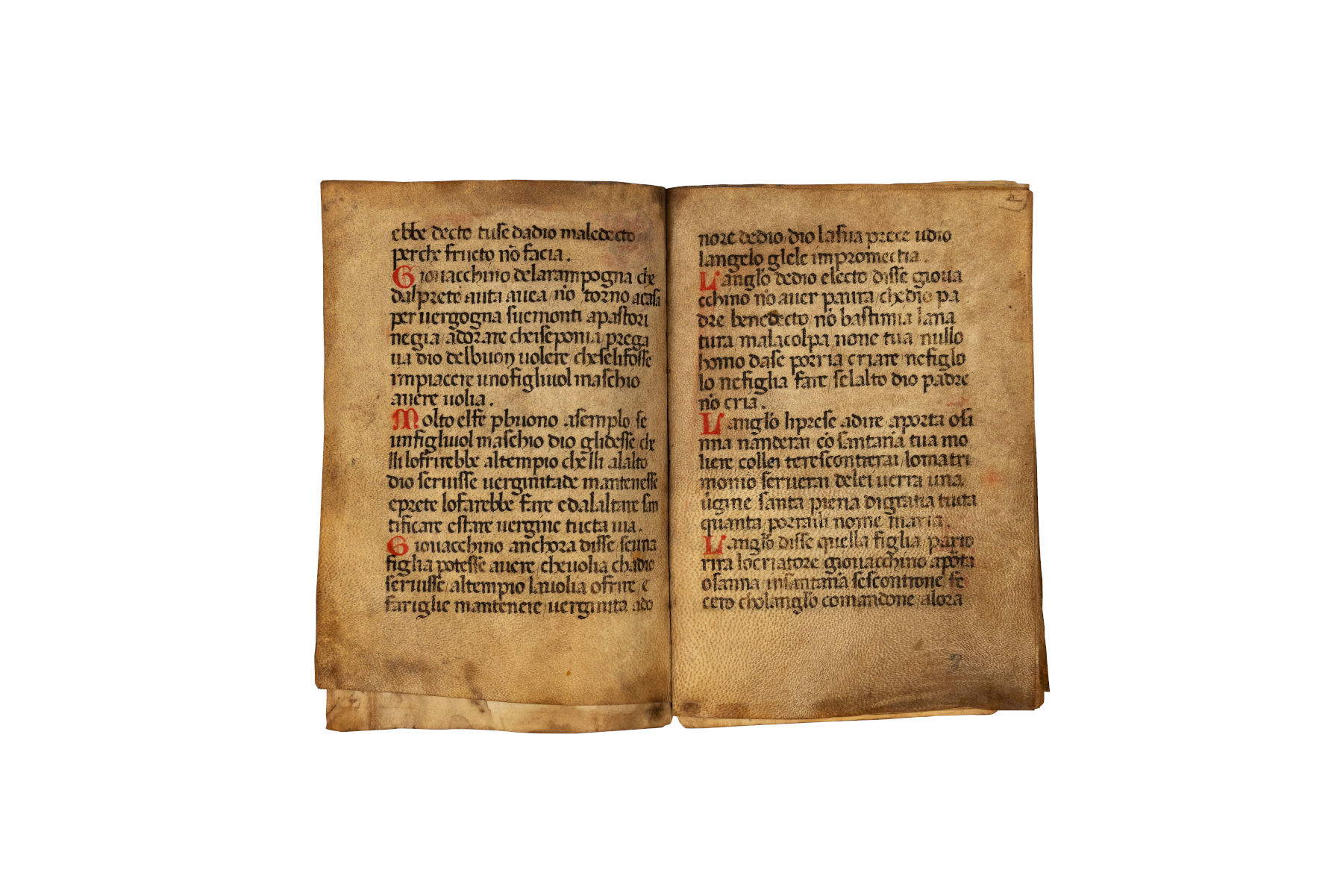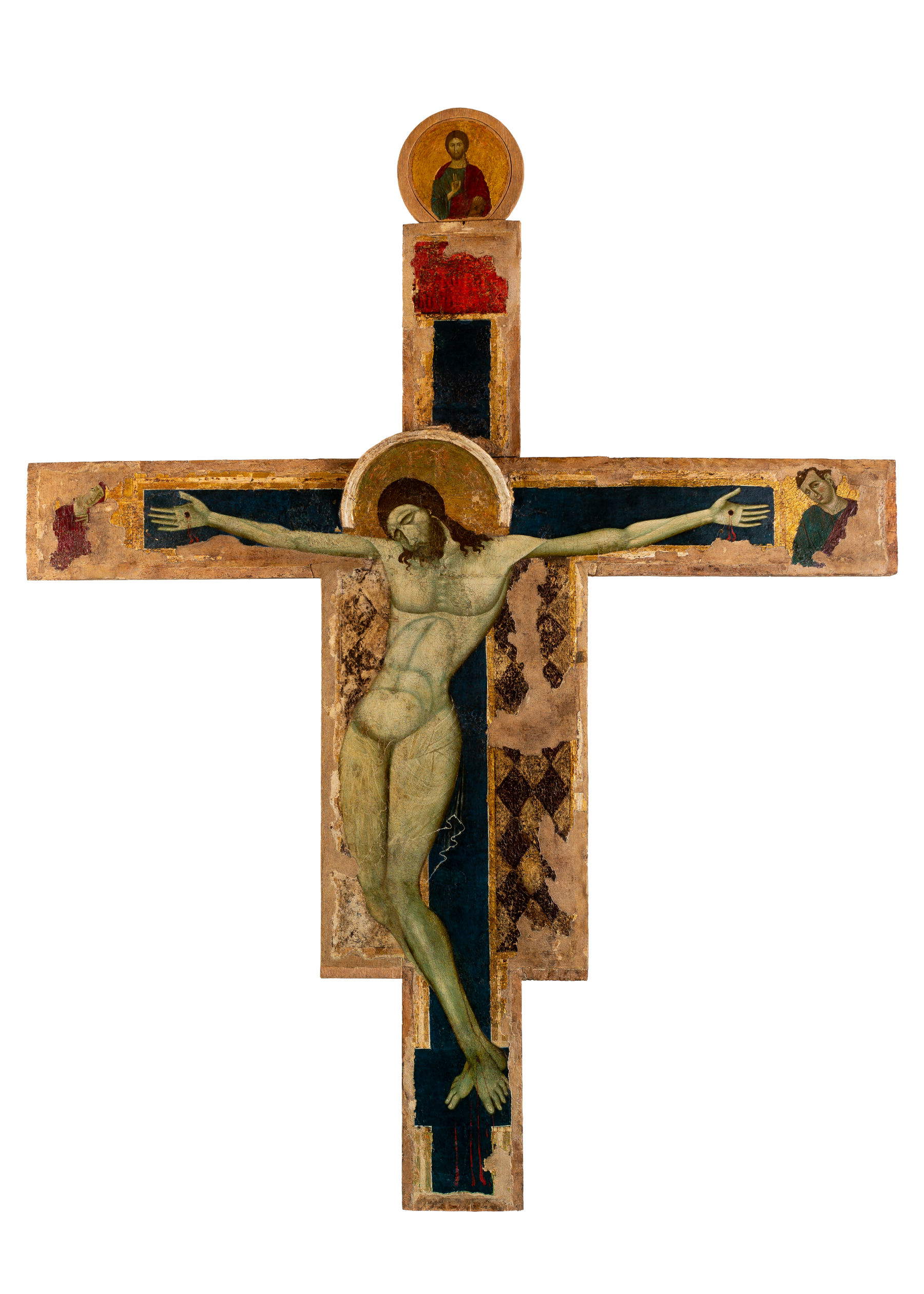From June 28 to October 5, 2025, the Museum of the Etruscan Academy and the City of Cortona (MAEC) is hosting the exhibition Singing the Middle Ages. Lauda in Cortona between Devotion and Civic Identity, curated by Francesco Zimei, professor of Musicology and History of Music at the University of Trento. The exhibition, promoted by the Accademia Etrusca and the Municipality of Cortona in collaboration with the Centro Studi Frate Elia da Cortona and the Diocese of Arezzo-Cortona-Sansepolcro, is supported by the European ERC Advanced project “Laudae” and is an opportunity to observe for the first time together the four Cortona laudaries preserved in different institutions.
The centerpiece of the exhibition is manuscript 91 in the Library of the Municipality and the Etruscan Academy, known as the Laudario of Cortona, considered the oldest extant collection of songs in the Italian language. The exhibition offers an articulated historical and cultural reading of it, placing it in a broader context of laudatory production that developed in Cortona between the 13th and 15th centuries. The term “lauda” refers to those spiritual songs in the vernacular that, beginning in the 13th century, spread widely in Italy. Giving the initial impetus to this genre was St. Francis’ Canticle of Brother Sun, composed in an Umbrian vernacular of extraordinary expressive force. It was precisely in Cortona, around the figure of Brother Elias, that the Franciscan text continued to be performed by some of the saint’s earliest followers, even before religious confraternities systematically adopted the lauda as a means of prayer and aggregation.

“With this exhibition,” says Cortona Mayor Luciano Meoni, “our city offers its historical and cultural contribution to the celebrations dedicated to St. Francis that will culminate in 2026. As part of the ’Cortona città francescana’ initiative, we want to offer fellow citizens an experience of knowledge and rediscovery of the roots of our community, and we want to share these values with the many visitors and pilgrims who will have the opportunity to discover this additional profile. Cortona was a city profoundly marked by the life of the patron saint of Italy, and for this I thank all those who created the exhibition event, starting with the historical evidence and enhancing the artifacts and monuments associated with it.”
“The exhibition offers a fascinating immersion into the world of popular devotion between the 13th and 15th centuries in our city,” says Cortona City Councilor for Culture Francesco Attesti. “Through manuscripts and poetic texts of extraordinary spiritual intensity; the exhibition reveals the central role of devotional singing in the religious and social life of the Middle Ages. A valuable opportunity to rediscover the roots of our musical and literary tradition that highlights how important that historical period was for Cortona.”
“Thanks to the willingness and support of the Accademia Etrusca and the entire Cortonese community,” says exhibition curator Francesco Zimei, “for some years now it has been possible to open a new, exciting front of research into the origins and characteristics of the laudatory repertoire, in this case with particular regard to that sung in the Umbrian-Tuscan area: a decisive practice not only for the study of the genre but of the very relationships between music and poetry in the early centuries of our language. The opportunity to bring together much of this research in an exhibition such as Singing the Middle Ages constitutes an unmissable opportunity not only in the perspective of interdisciplinary studies, but also to raise awareness of the importance of folk singing.”

The documentary exhibition set up at MAEC offers an integral display of the four Cortona laudaries known today: Codex 91, from the Convent of St. Francis and present in the Cortona library since 1866; manuscript 462, a file also kept in the Library of the Accademia Etrusca; manuscript 180 in the Città di Arezzo Library, once belonging to the Cortona confraternity of St. Augustine; and finally manuscript 535, currently kept in the Trivulziana Library in Milan. The philological, linguistic and historical relevance of these materials is remarkable: not only do they testify to the liturgical-musical use of vernacular texts, but they also constitute a fundamental source for the study of the origins of Italian poetry and vernacular as a literary language. Accidentally discovered in 1874 in a stairwell of the Cortona Library, the Laudario di Cortona documents confraternal activity as early as the second half of the thirteenth century, a time when laude were sung during religious festivals, processions and moments of public prayer. While they represented an expression of popular devotion accessible even to the less educated classes, they were also instruments of social cohesion in a historical phase marked by strong tensions between city factions, such as those between Guelphs and Ghibellines. Devotional singing, in addition to being a religious practice, was thus configured as a rite of civic belonging. Alongside the original manuscripts, the exhibition provides the public with interactive digital totems, which allow them to virtually explore the pages of the codices and listen to some of the selected laude, performed by musical groups specializing in medieval repertoires.

Other notable materials complete the exhibition itinerary. These include a collection of religious cantari today preserved at the National Central Library in Florence, but of Cortonese provenance, which includes the Cantare in octaves on St. Margaret of Cortona and the Passion of Cicerchia of Siena. Then there is the original 1325 City Statute, preserved in the Florence State Archives, which allows us to frame the norms of public life in the cultural and political context coeval with the spread of lauda. Another relevant document is an unpublished codex containing the Legenda of Blessed Guido, kept at the monastery of Santa Chiara, which is flanked by confraternal documents and episcopal bulls attesting to the ecclesiastical recognition of laudatory practices, such as the indulgence for those who participated in devotional singing.
The exhibits also include the authenticated bull Vigilis speculatoris of Pope John XXII, part of the collections of the Accademia Etrusca. The exhibition thus offers a layered look at medieval Cortona, between religious ferments and the construction of civic identity. It traces fundamental events in the town’s history such as the clashes between political factions, the rise of the Signoria dei Casali, the establishment of the diocese and the relationships of alliance and conflict with neighboring centers. In this picture, the image emerges of a frontier city, projected more toward Perugia than toward Arezzo or Florence, in which cultural and religious production was intertwined with the very definition of the sense of community belonging. In addition to documents and codices, the MAEC also exhibits works of art closely related to the religious and confraternal context. These include the painted Cross from the end of the 13th century, from the church of San Francesco, and a panel painting depicting episodes from the life of St. Margaret of Cortona, from the monastery of Santa Chiara and now housed in the Diocesan Museum.

The exhibition ideally concludes with the reconstruction of the Laudesi Chapel in the church of San Francesco, restored to its 14th-century appearance thanks to the joint work of art historians and scholars of religious architecture. The exhibition itinerary also extends outside the MAEC, touching on some of the city places linked to the history of lauda: St. Francis’ church itself, founded by Brother Elias and second in antiquity only to the basilica in Assisi; the church of San Niccolò, which preserves confraternal robes and a banner painted by Luca Signorelli in 1510; and finally the Eremo delle Celle, where St. Francis stayed several times and, according to some sources, wrote his Spiritual Testament.
The Accademia Etrusca, on the voice of Lucumone Luigi Donati and Vice Lucumone Paolo Bruschetti, stresses that the initiative was created with the intention of enhancing a key document of Cortona’s bibliographic history, such as the Laudario di Cortona and its rediscoverer Girolamo Mancini, but also to fill a gap in the knowledge of the city’s Middle Ages, a period that played a central role in defining Cortona’s historical identity. The exhibition is part of a project continuity with other recent exhibitions aimed at bringing out specific aspects of local history, art and culture through the MAEC and Library collections. In parallel with the exhibition, the City of Cortona will host a series of collateral events, including concerts, meetings and conferences. Of particular note is the international conference The Origins of Laude/Laude of the Origins. At the roots of spiritual singing in the vernacular in the eighth centenary of the Canticle of Brother Sun, scheduled for September 4-6, 2025. Organized as part of the ERC project Advanced The Italian Lauda: Disseminating Poetry and Concepts Through Melody, 12th-16th centuries, directed by Francesco Zimei himself, the conference aims to explore the connections between music, poetry and spirituality at the origins of the lauda, highlighting the decisive contribution made by Franciscans, the so-called “jesters of God,” in the dissemination of this repertoire.
Hours: daily 10 a.m. - 7 p.m.
Tickets: Full: € 10.00 | Reduced: € 7.00
 |
| Medieval chants are rediscovered in Cortona: the city's four ancient laudaries on display |
Warning: the translation into English of the original Italian article was created using automatic tools. We undertake to review all articles, but we do not guarantee the total absence of inaccuracies in the translation due to the program. You can find the original by clicking on the ITA button. If you find any mistake,please contact us.